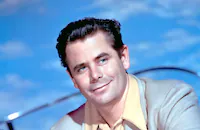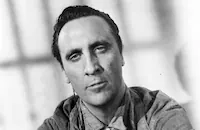A Time for Killing

Brief Synopsis
Cast & Crew
Phil Karlson
Inger Stevens
Glenn Ford
Paul Petersen
Timothy Carey
Kenneth Tobey
Film Details
Technical Specs

Synopsis
Near the end of the Civil War, a Confederate prisoner is sentenced to death for killing a Union guard while attempting to escape from Fort Hawkes, Utah. When he insults the fort's commanding officer, the military execution squad is replaced by Negro orderlies. Enraged by this humiliation, the Rebels' ranking officer, Capt. Dorrit Bentley, effects a mass escape by blowing up the fort. While on the run, he and his men kill a detail of Union soldiers and take as hostage Emily Biddle, a missionary engaged to the fort's second-in-command, Maj. Charles Wolcott. Wolcott is ordered to lead a pursuit party, and Bentley's men make their way to a small town in the Arizona badlands, where they plan to ambush their pursuers. Bentley allows one of his men to kill a Union dispatch rider in a saloon and learns from the victim's papers that Lee has surrendered at Appomattox. Although he conceals the news from his men, Bentley divulges the information to Emily, then rapes and beats her into unconsciousness before heading toward the Mexican border with his troops. Wolcott and his men enter town, and Emily, just as Bentley intended, withholds the news about the war and demands that he track down and kill the captain. The two men finally clash in a deserted mission at the Arizona-Mexico border; Bentley is mortally wounded but has his moment of triumph by telling Wolcott both of the war's end and of Emily's knowledge of the fact. Dazed, Wolcott and the remaining survivors of the senseless conflict begin the long trek home, with Emily following behind them.

Director

Phil Karlson
Cast

Inger Stevens

Glenn Ford
Paul Petersen

Timothy Carey

Kenneth Tobey
Richard X. Slattery

Harrison Ford
Kay E. Kuter
Dick Miller
Emile Meyer
Marshall Reed

George Hamilton
Todd Armstrong
Duke Hobbie

Dean Stanton
James Davidson
Charlie Briggs
Craig Curtis
Jay Ripley
Dean Goodhill
Crew
Jack Ahern
Van Alexander
Van Alexander
Wallace Bennett
Jack Bohrer
Karl Brainard
David Breen
Harry Joe Brown
Roger Corman
Department Of The Interior
Mike Frankovich Jr.
Lloyd Garnell
Glen Canyon National Recreation Area
Daniel Haller
Jack Haynes
Monte Hellman
Virginia Jones
Ben Lane
Roy Livingston
Mundell Lowe
Philip Mitchell
Kenneth Peach
Anthony Ray
Charles J. Rice
Richard Rubin
Homer Van Pelt
Ned Washington
Halsted Welles
George White

Film Details
Technical Specs

Articles
A Time for Killing
Although her home life was now more intact than it had been in years, Inger had no illusions about the sanctity of family. Running away at age sixteen, she worked for a time as a burlesque dancer in Kansas, where a remarried Per Stensland had assumed a university position. Brought back by her father, Inger would leave again for good two years later. In New York City, she danced as a chorus girl, augmenting her income with work in the garment district. While studying at the Actor's Studio, she landed her first commercial and an agent, who changed her name to Inger Stevens and became her first husband. The marriage was short-lived but Inger was on her way.
Stevens made her Broadway debut in 1956 and worked regularly in live television. She made her film debut in MGM's Man on Fire (1957), opposite Bing Crosby, with whom she fell in love. The breakup of that relationship pushed Inger to her first suicide attempt, on New Year's Day, 1960. Despite being hobbled by depression, she worked steadily through the next decade, with roles on screens large and small, and replaced Barbara Bel Geddes' in the Broadway run of Jean Kerr's comedy Mary, Mary. Her greatest fame came as the star of the Screen Gems/ABC sitcom The Farmer's Daughter, in the role created by Loretta Young for RKO's 1947 film version. The series lasted three years and netted Inger Stevens a Golden Globe. When the show folded, she had several offers for work in features.
A Time for Killing (1967) was hardly a glamour assignment for Inger, who surely looked upon the violent western as another paycheck. Playing the kidnapped (by George Hamilton) fiancée of a Union officer during the last days of the Civil War did give her the opportunity to work with Hollywood legend Glenn Ford. Adapted by Halsted Welles (3:10 to Yuma, 1957) from the 1961 novel The Southern Blade by Colby Wolford and Harley Duncan (writing as Nelson and Shirley Wolford), the project was set to be directed by Roger Corman. The success of Corman's Edgar Allan Poe films had won him a development deal with Columbia. The studio nixed most of Corman's ideas (he made The Wild Angels [1966] on leave of absence) until finally agreeing to A Time for Killing, then called The Long Ride Home.
Corman hired Robert Towne to work on the script, participated in casting and location scouting, and was on location in Utah's Zion National Park when his customary frugality sent up red flags in the executive suites at Columbia. Although Corman was merely trying to get the most mileage out of his $2 million budget, the fear at the studio was that the project would end up looking cheap. Corman was summarily released from his contract and Phil Karlson (fresh from heading up The Silencers [1966], Columbia's initial entry in the "Matt Helm" series of spy spoofs starring Dean Martin) was placed in the director's chair. (Corman's protégé, Monte Hellmann, who had cut The Wild Angels, resigned from the picture in protest and was replaced by Roy Livingston.) Corman bounced from this disappointment to 20th Century Fox, where his The St. Valentine's Day Massacre was a big earner in 1967. A box office nonstarter in November 1967, A Time for Killing is of more interest now due to early appearances by Harry Dean Stanton and a twenty five-year old Harrison Ford. It would be a decade before either actor broke through to name recognition Stanton in a run of gritty films (including Straight Time [1978], Alien [1979] and Paris, Texas [1984]) and Ford in Star Wars (1977) and Raiders of the Lost Ark (1981) and their respective sequels. By that time, Inger Stevens was long gone. She had enjoyed a succession of high profile assignments, acting for Gene Kelly in A Guide for the Married Man (1967), appearing opposite Henry Fonda and Jimmy Stewart in Firecreek (1968), reunited with Dean Martin for Five Card Stud (1968) and helping Clint Eastwood import his success in spaghetti westerns to America with Hang 'Em High (1968).
Rumors had long circulated of on-set love trysts (with Martin, Eastwood, James Mason, Anthony Quinn, Harry Belafonte) but what wasn't widely known at the time of her death was that Inger had married black entrepreneur Ike Jones in Mexico in 1961. In the spring of 1970, Inger completed a movie of the week with Burt Reynolds, with whom she is alleged to have had a tempestuous affair. The morning after a quarrel with Reynolds, she was discovered semiconscious in her Hollywood Hills home and died later that day. The coroner's report attributed her death to "acute barbiturate intoxication due to ingestion of overdose." She was thirty five years old.
Producer: Harry Joe Brown
Director: Phil Karlson, Roger Corman (uncredited)
Screenplay: Halsted Welles; Nelson Wolford, Shirley Wolford (novel "The Southern Blade")
Cinematography: Kenneth Peach
Art Direction: Daniel Haller
Music: Mundell Lowe
Film Editing: Roy Livingston
Cast: Inger Stevens (Emily Biddle), Glenn Ford (Maj. Tom Wolcott), Paul Petersen (Blue Lake), Timothy Carey (Billy Cat), Kenneth Tobey (Sgt. Cleehan), Richard X. Slattery (Cpl. Paddy Darling), Harrison J. Ford (Lt Shaffer), Kay E. Kuter (Owelson), Dick Miller (Zollicoffer), Emile Meyer (Col. Harries), Marshall Reed (Stedner), George Hamilton (Capt. Dorrit Bentley), Max Baer Jr. (Sgt. Luther Liskell), Todd Armstrong (Lt. 'Pru' Prudessing), Duke Hobbie (Lt. Frist), Dean Stanton (Sgt. Dan Way), James Davidson (Little Mo), Charlie Briggs (Sgt. Kettlinger), Craig Curtis (Bagnef), Jay Ripley (Cpl. Timothy Dwight Lovingwood), Dean Goodhill (Bruce).
C-89m. Letterboxed. Closed Captioning.
by Richard Harland Smith
Sources:
The Farmer's Daughter Remembered: The Biography of Actress Inger Stevens by William T. Patterson
Roger Corman: An Unauthorized Life by Beverly Gray
Roger Corman: Metaphysics on a Shoestrong by Alain Silver and James Ursini
How I Made a Hundred Movies in Hollywood and Never Lost a Dime by Roger Corman
The Films of Harrison Ford by Lee Pfeiffer and Michael Lewis
The Inger Stevens Memorial Website, www.ingerstevens.com

A Time for Killing
Kenneth Tobey (1917-2003)
Born in Oakland, California on March 23, 1917, Tobey originally intended to be a lawyer before a stint with the University of California Little Theater changed his mind. From there, he went straight to New York and spent nearly two years studying acting at the Neighborhood Playhouse, where his classmates included Gregory Peck, Eli Wallach and Tony Randall. Throughout the '40s, Tobey acted on Broadway and in stock before relocating to Hollywood. Once there, Tobey soon found himself playing a tough soldier in films like I Was a Male War Bride and Twelve O' Clock High (both 1949); or a tough police officer in Kiss Tomorrow Goodbye and Three Secrets (both 1950). Such roles were hardly surprising, given Tobey's craggy features, unsmiling countenance and rough voice.
Needless to say, no-nonsense, authority figures would be Tobey's calling for the remainder of his career; yet given the right role, he had the talent to make it memorable: the smart, likeable Captain Hendrey in The Thing From Another World (1951); the gallant Colonel Jack Evans in the "prehistoric dinosaur attacks an urban center" genre chiller The Beast from 20,000 Fathoms (1953, a must-see film for fans of special effects wizard, Ray Harryhausen; and as Bat Masterson, holding his own against Kirk Douglas and Burt Lancaster in Gunfight at the O.K. Corral (1957).
Television would also offer Tobey much work: he had his own action series as chopper pilot Chuck Martin in Whirlybirds (1957-59); and had a recurring role as Assistant District Attorney Alvin in Perry Mason (1957-66). He would also be kept busy with guest appearances in countless westerns (Gunsmoke, Bonanza, The Virginian) and cop shows (The Rockford Files, Barnaby Jones, Ironside) for the next two decades. Most amusingly, the tail end of Tobey's career saw some self-deprecating cameo spots in such contemporary shockers as The Howling (1981); Strange Invaders (1983) and his role reprisal of Captain Hendry in The Attack of the B-Movie Monsters (2002). Tobey is survived by a daughter, two stepchildren, and two grandchildren.
by Michael T. Toole
Kenneth Tobey (1917-2003)
Quotes
Trivia
Notes
Location scenes filmed in Zion National Park, Utah, and Glen Canyon National Recreation Area, Arizona-Utah. Working title: The Long Ride Home. Corman withdrew as co-producer and was replaced as director by Karlson several weeks into production. Hellman was replaced as editor several weeks later.

Miscellaneous Notes
Released in United States 1967
Released in United States 1967













